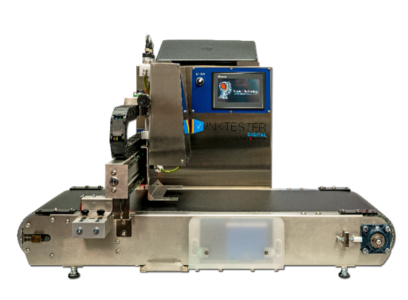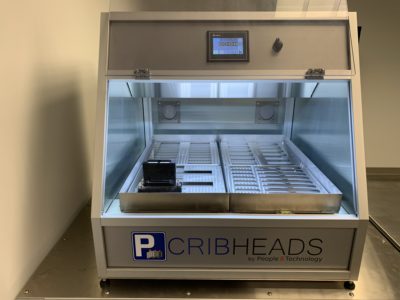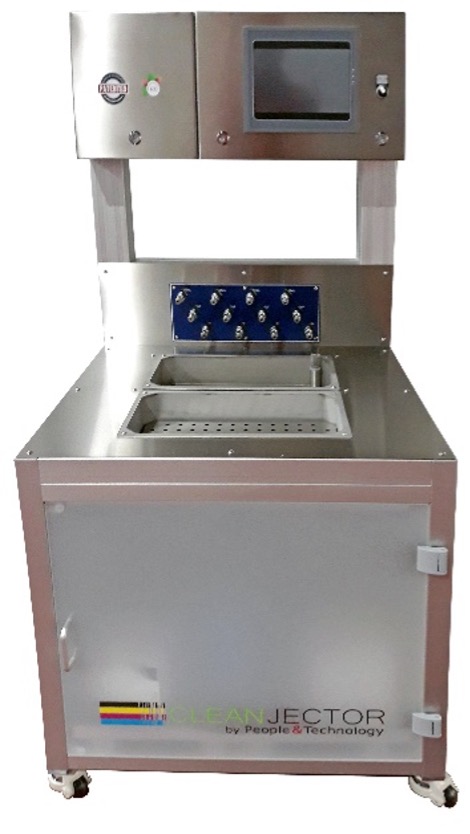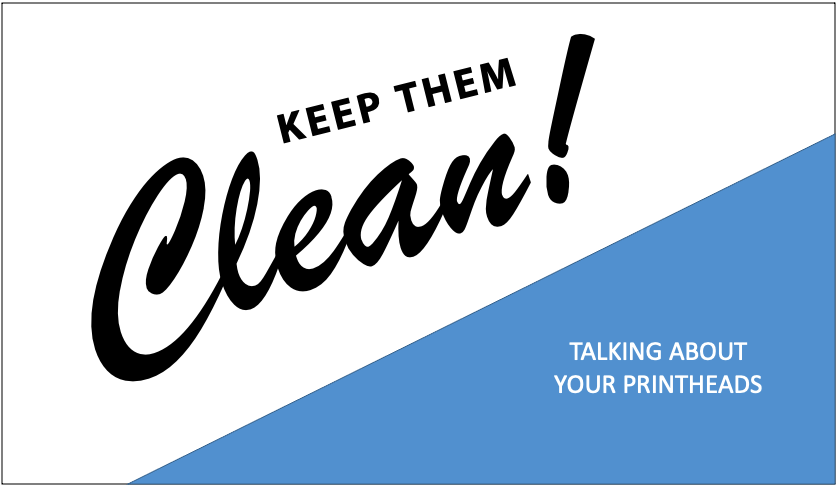Keeping inkjet printheads clean and clear has been the focus of a great deal of research and development into heads, fluids, circulation systems, automatic wiping systems and more. Printhead maintenance is important for print quality, head life and overall operating efficiency. The replacement of print head systems is one of the highest variable costs in an inkjet solution, not including the volume of ink used. Reducing the consumption of print heads can have a major impact on operating costs, but there are few avenues for inkjet press owners to perform more than the standard preventive maintenance recommended by their OEM.
Recently I spoke with Martin Brabenec of Graphic Solid Inks, Inc. (GSI) based in Alpharetta Georgia about their interest in bringing a better head cleaning option to market. I asked Martin about the types of companies that might have a need to for their own head cleaning system. Within companies using inkjet he noted that a system would be appealing to companies who are using a high volume of printheads, have very high print quality requirements and are concerned with sustainability. Martin notes, “The difference in cost for a new head versus a recovered head is around 70%. Also being able to clean printheads on demand and schedule periodic preventive printhead maintenance instead of a palliative care assures a 100% print quality. Doing the work onsite avoids shipping and waitlist turnaround times for recovered heads experienced when using an external cleaning service.”
Martin also sees companies that manufacture ink as potential customers because the cleaning system allows them to be more efficient in their R&D processes. Martin adds, “Different ink formulations have different effects on the printheads. Being able to recover heads when used with formulas that obstruct jets allows for quicker development times as well as more flexibility for the ink manufacturer.”
Sustainability is also a growing consideration. Currently there is no recycling program for printheads, which contain contaminating toxic components. Every year, hundreds of thousands of printheads are thrown away. “Cleaning and recovering heads contributes to the circular economy,” advises Martin.
In pursuing a solution for their own internal needs, GSI investigated printhead cleaning equipment from People & Technology. P&T, based in Castellón Spain, develops, designs and manufactures industrial printhead cleaning equipment specifically designed for digital inkjet printers jetting UV, ceramic and water-based inks. P&T has 300 customers worldwide and GSI is now their exclusive partner for sales, distribution and service in North America. GSI also offers printhead cleaning as a service using this technology. While P&T says that their technology is constantly improving, they currently claim a printhead recovery rate of “up to 93%.”
In discussing the inkjet printing markets where a cleaning solution cold have the most impact based on the cost of new heads, the tendency for blockage, and current recovery rates, Martin described a number of factors that have an impact on uptake.
“Systems that have more ‘aggressive’ inks, such as water based and ceramic inks, will have to clean their heads more frequently. But all industries are affected by obstructed heads,” says Martin. “All of the heads in all industries will eventually have to be cleaned or replaced, even the commercial print systems. Industrial printhead cleaning equipment is an untapped opportunity.”
Many companies have their own in-house technology that they use to try and clean printheads. There are also some smaller, portable, printhead flushing systems available such as Pantheon Systems typically used for field service, as well as various “Printhead Doctor” models available from Digital Sign Technologies. Martin considers the P&T technology to be more sophisticated with an industrial design that allows multiple heads to be cleaned at the same time and is tailored for particular heads to improve cleaning and recovery while reducing the potential for breakage. The process relies on multiple pieces of equipment beginning with InkTester Digital which evaluates nozzle status. The InkTester is used to test printheads before and during cleaning as well as by ink manufacturers for testing different types of inks and how they perform in different types of printheads.

InkTester Digital
This equipment has been developed in collaboration with the printhead manufacturers. Each printhead has its own recipe, provided by the manufacturer, which is easily selected from a menu. These recipes can be modified for different waveforms, positive and negative pressures, voltages, etc. Electronics are component based and interchangeable for different printhead makes and models. Depending on the state of the printhead, the next step may be a trip through the CribHeads pre-cleaning process.

The CribHeads system lowers the printhead into a cleaning solution. A circular movement creates waves in the cleaning solution gently cleaning the printhead nozzle plate and preparing it for the full cleaning cycle(s). Martin notes that this is especially useful when using water-based inks.
Following the CribHeads process, the printhead is again tested with the InkTester to see what progress has been made. Then the head is transferred to the CleanJector for an in-depth cleaning.

This equipment has also been developed in collaboration with numerous printhead manufacturers. Each make and model of head has its own recipe, ensuring that the right pressure is used, the right ultrasound and the appropriate amount of time. Most printhead models are attached to an adaptor that creates a closed circuit to initially reverse the flow of the cleaning liquid. This allows any obstruction or particulates to be safely extracted through the back instead of being pushed out through the nozzles. Once this extraction process is done, the cleaning fluid is recirculated through the printhead, intermittently adding “prescribed” ultra sound treatment. The approach will vary automatically depending on the recipe for the particular make and model of printhead being cleaned. A full, automated cycle takes 24 hours after which the printhead is again tested in the InkTester.
Since the complete solution uses 3 different pieces of equipment it requires the printhead to be handled during the process. However, the process at each step is fully automated and P&T has put strong focus on making the system easy to use. This extends to a multi-language interface that has been successfully marketed in 30 countries. The company claims compatibility with all major industrial inkjet brands.
We don’t expect to see the typical commercial inkjet user running out to purchase a head cleaning system in the near term, but there is a growing market among companies with a fleet of inkjet systems, bespoke inkjet environments, integrators supporting customized inkjet installations as well as ink developers, OEMs and others involved with inkjet research and development. There is likely also a market for some number of equipment service providers who want to add inkjet recovery to their book of business. Currently, many commercial inkjet OEM agreements state that used heads must be returned to the OEM and service agreements may not allow for in-house servicing of heads other than normal maintenance such as wipes and system flushing. As further proof-points emerge on the cost effectiveness of printhead cleaning systems, inkjet users may seek to change this dynamic to gain more of the benefits of inkjet printhead recovery and reuse. Meanwhile the industrial inkjet markets tend to have a more open approach to printhead recovery.
Roberto Campos Orgaz of People & Technology notes that inkjet market penetration in ceramic tile printing is very high. “We are talking about a worldwide installed market of around 5,000 printers, with an average of 50 heads per printer.” P&T is also very interested in the corrugated and textile segments. Roberto says, “In these two markets, we are talking about printers that have an average of more than 100 heads each and a potential global install base of more than 50,000 printers.” Even before factoring in other, smaller industrial markets this equates to millions of printheads where neither the head manufacturers nor the OEM integrators typically collect the printheads from customers.
Earth-friendly, profitable recycling
These inkjet markets are familiar ground for GSI. The company started out by manufacturing specialty inks and then branched out to distributing various types of equipment for the coding & marking industry. They have further expanded into developing and manufacturing printers. This made GSI initially an excellent customer for P&T’s head cleaning systems and once the technology was proven to meet their own R&D needs, GSI leveraged their distributor roots to represent the technology to their client base in North America.
Printheads are pricey and recycling makes sound economic, as well as environmental, sense. While there are printheads on the market that cost less than $800 (700 EUR), high-end, industrial heads from Fujifilm Dimatix, Kyocera, Ricoh, Seiko and Xaar typically reach end customers at a cost of between $2,400 and $8,000 (2,000 – 6,800 EUR) per unit. This creates a strong economic incentive to prolong the use, and enable the reclamation of printheads in the industrial inkjet market.

